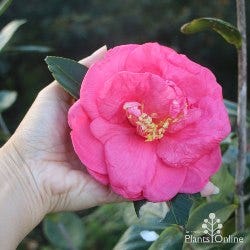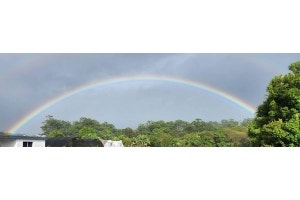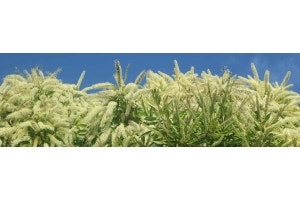
Camellia - the tea plant
 Camellia is the plant genus from where we get our morning cuppa. The tea leaves come from the young new shoots of the Camellia sinensis plant, and the younger and newer the leaf, the more expensive and prized the tea that results. So here at Australian Plants Online, where we are powered by tea, we appreciate camellias very much! Camellia sinensis - shown here in the photo - is not a species you'll find in our nursery, or in the typical Australian garden, however. That honour goes to two other kinds of Camellia, grown for their showy flowers rather than their delicious leaves.
Camellia is the plant genus from where we get our morning cuppa. The tea leaves come from the young new shoots of the Camellia sinensis plant, and the younger and newer the leaf, the more expensive and prized the tea that results. So here at Australian Plants Online, where we are powered by tea, we appreciate camellias very much! Camellia sinensis - shown here in the photo - is not a species you'll find in our nursery, or in the typical Australian garden, however. That honour goes to two other kinds of Camellia, grown for their showy flowers rather than their delicious leaves.Sasanqua or Japonica - which is better?
 There are two main species of ornamental Camellia found in Australian gardens - Camellia sasanqua, and Camellia japonica. Both are generous with their peony-like flowers, which first appear towards the beginning of winter when we're in need of colour, and continue into spring. When camellias flower can depend on the local climate, with milder conditions bringing on earlier blooms. In our Sunshine Coast nursery they often start blooming in late autumn!Both kinds of camellia like the same kind of conditions as azaleas and gardenias - rich deep loamy soil, slightly on the acid side, and regular water. Planted together, they make excellent companions.
There are two main species of ornamental Camellia found in Australian gardens - Camellia sasanqua, and Camellia japonica. Both are generous with their peony-like flowers, which first appear towards the beginning of winter when we're in need of colour, and continue into spring. When camellias flower can depend on the local climate, with milder conditions bringing on earlier blooms. In our Sunshine Coast nursery they often start blooming in late autumn!Both kinds of camellia like the same kind of conditions as azaleas and gardenias - rich deep loamy soil, slightly on the acid side, and regular water. Planted together, they make excellent companions.

Camellia sasanqua - for warmer humid climates
Camellia sasanqua is often called the ‘tough camellia’. This Camellia type is more sun tolerant, can cope with heat and humidity better, and is fine in deep shade too. Camellia sasanqua is generally faster-growing than Camellia japonica – very useful if you’re looking to grow a beautiful camellia hedge in a hurry. Sasanqua needs a sheltered site to thrive best in southern locations, where it might get frost.In more humid northern areas Camellia sasanqua will be right at home in a range of sites and spots - though it will bloom better in a less wind-exposed site, and with regular irrigation.

The flowers - which can be single cup-shaped blooms or more ornate loose flowers with multiple petals - start to arrive in late autumn when other plants are going to sleep, and power on through into spring. The dark green glossy leaves look elegant and evergreen all year round.
Camellia sasanqua plants make an excellent flowering evergreen screen as they can be clipped to a narrow formal shape, or left to grow naturally in a more informal-style garden, where those blousy blooms look right at home.

Camellia japonica - for cooler dry climates
Camellia japonica is the more commonly-found ornamental form of the plant worldwide, especially in European gardens.It is less sun and heat tolerant, and will be happier in a cooler, semi-shaded location. Japonicas prefer a western-facing site so the morning sun doesn’t scorch any dew or frost that might be on the flower petals. Japonica camellias can cope with a less sheltered position in southern locations than sasanqua camellias can, and can tolerate a certain amount of chill, and even light frost.

The flowers are usually smaller than sasanqua, and unscented. Some have a neat, regular, symmetrical form that is very distinctive; some are loose and irregular like sasanqua flowers. The dark green glossy leaves look elegant and evergreen all year round. Camellia japonica plants make an excellent hedge, or a feature shrub in the border. Japonica camellias are typically slower growing than sasanqua so if you want a taller hedge, you’ll need some patience, but that's useful if you have a small back yard. Camellia japonica make lovely potted plants too, which is good if your garden has alkaline soil, as you can grow them in potting compost or the neutral-acid loam they prefer.

Camellia reticulata - trees for subtropics
You might also see Camellia reticulata, as in our variety 'Flower Girl'. Reticulata camellias can grow into small trees, and the flowers are large and full. They bloom from late winter until late spring, later than most other camellia species. They don't like cold, so this reticulata species is one for northern states and sheltered spots, unless you can overwinter it indoors.We also have Camellia hiemalis, which is a cross between sasanqua and japonica camellias, giving you the best of both worlds.Camellia - lots of variety
 The camellias we sell at Australian Plants Online range from pure white, through pale pink, and rose-pink, to deep magenta-purples and ruby reds. Within that little corner of the rainbow you'll find a wide variety of flower shapes, shades, sizes, and even scents.
We promised a scented camellia and pale pink Exquisite (shown here) is the one to choose! Up close with your nose in the bloom it's a gentle faint fragrance; move away and it's a sweet easy-to-detect scent that floats towards you on the warm spring breeze, perfuming the corners of your garden.
The camellias we sell at Australian Plants Online range from pure white, through pale pink, and rose-pink, to deep magenta-purples and ruby reds. Within that little corner of the rainbow you'll find a wide variety of flower shapes, shades, sizes, and even scents.
We promised a scented camellia and pale pink Exquisite (shown here) is the one to choose! Up close with your nose in the bloom it's a gentle faint fragrance; move away and it's a sweet easy-to-detect scent that floats towards you on the warm spring breeze, perfuming the corners of your garden.  Some camellias have smaller golfball-sized many-petalled blooms in abundance - like Sparkling Burgundy in our header image, and Bonanza. Some camellias have enormous open single flowers, that need two hands to hold them - these are ideal for pollinators to feed at. The single-flowered varieties often have bright golden centres that create a striking colour contrast, especially with deeper-coloured petals, such as Yuletide (shown), Dazzler, and Hiryu.
Some camellias have smaller golfball-sized many-petalled blooms in abundance - like Sparkling Burgundy in our header image, and Bonanza. Some camellias have enormous open single flowers, that need two hands to hold them - these are ideal for pollinators to feed at. The single-flowered varieties often have bright golden centres that create a striking colour contrast, especially with deeper-coloured petals, such as Yuletide (shown), Dazzler, and Hiryu.
 The outer petals or petal tips are often subtly shaded in a deeper colour which pales towards the centre of the camellia flower, creating a beautiful effect. Barbara Louise, Pure Silk and Weroona all have this very pretty shaded colouration.Neat and evergreen, flowering in winter, happy in a pot or as a hedge - and blooming in a range of pretty shades. Can you find a place for a Camellia in your garden?
The outer petals or petal tips are often subtly shaded in a deeper colour which pales towards the centre of the camellia flower, creating a beautiful effect. Barbara Louise, Pure Silk and Weroona all have this very pretty shaded colouration.Neat and evergreen, flowering in winter, happy in a pot or as a hedge - and blooming in a range of pretty shades. Can you find a place for a Camellia in your garden?



























